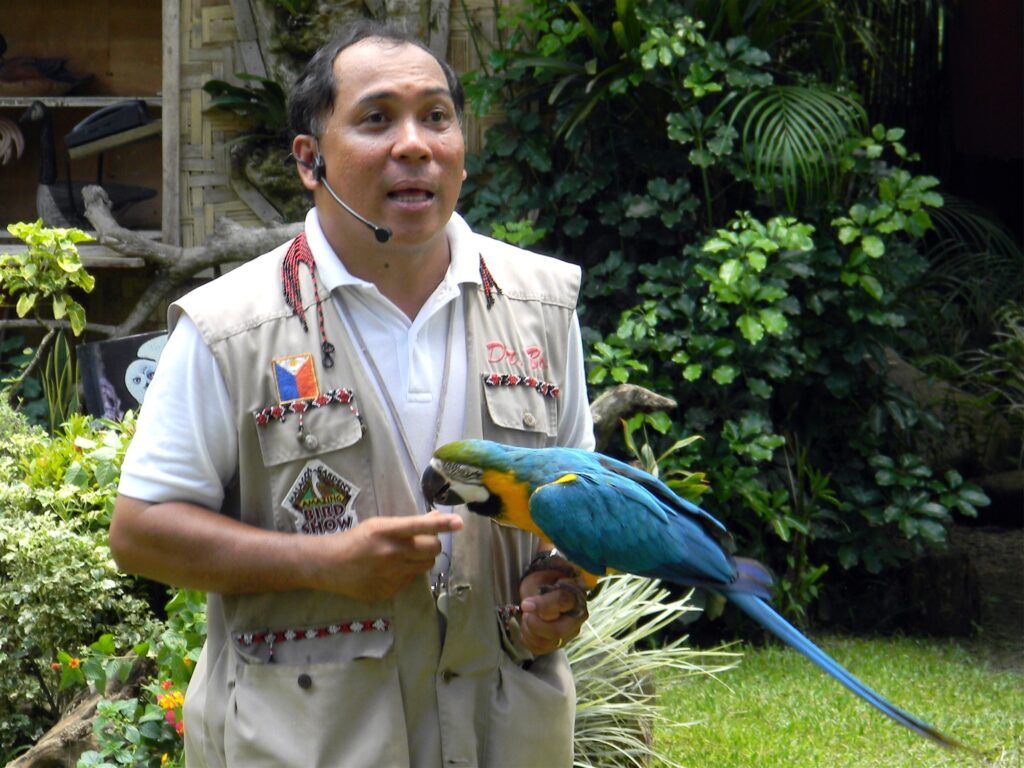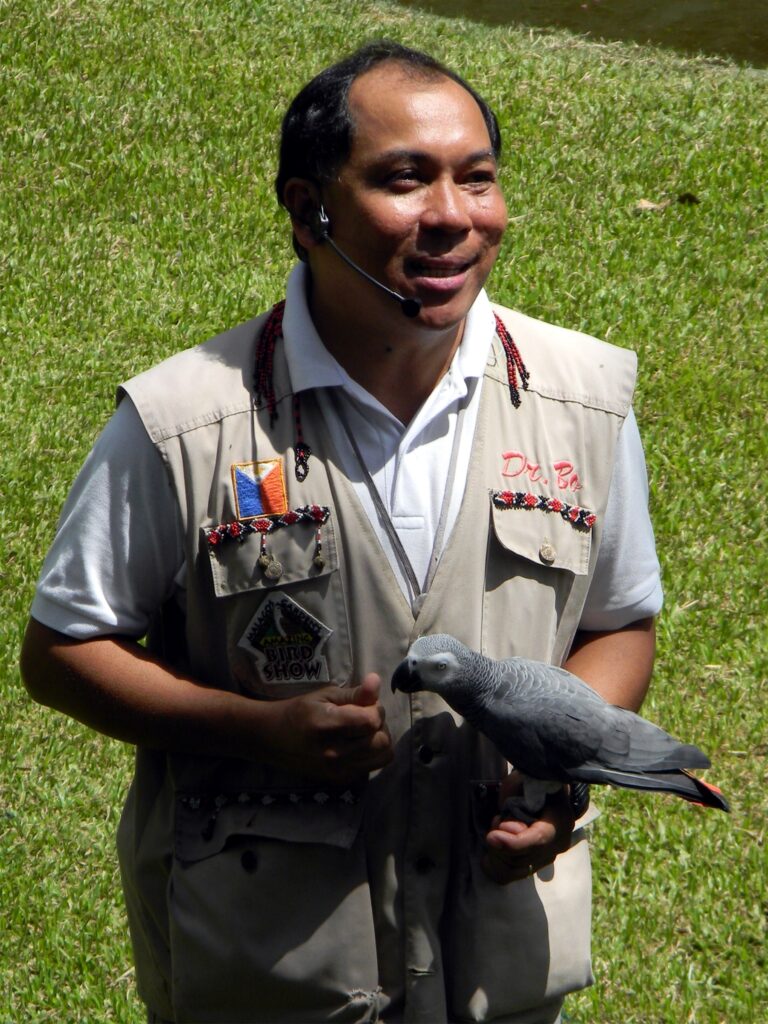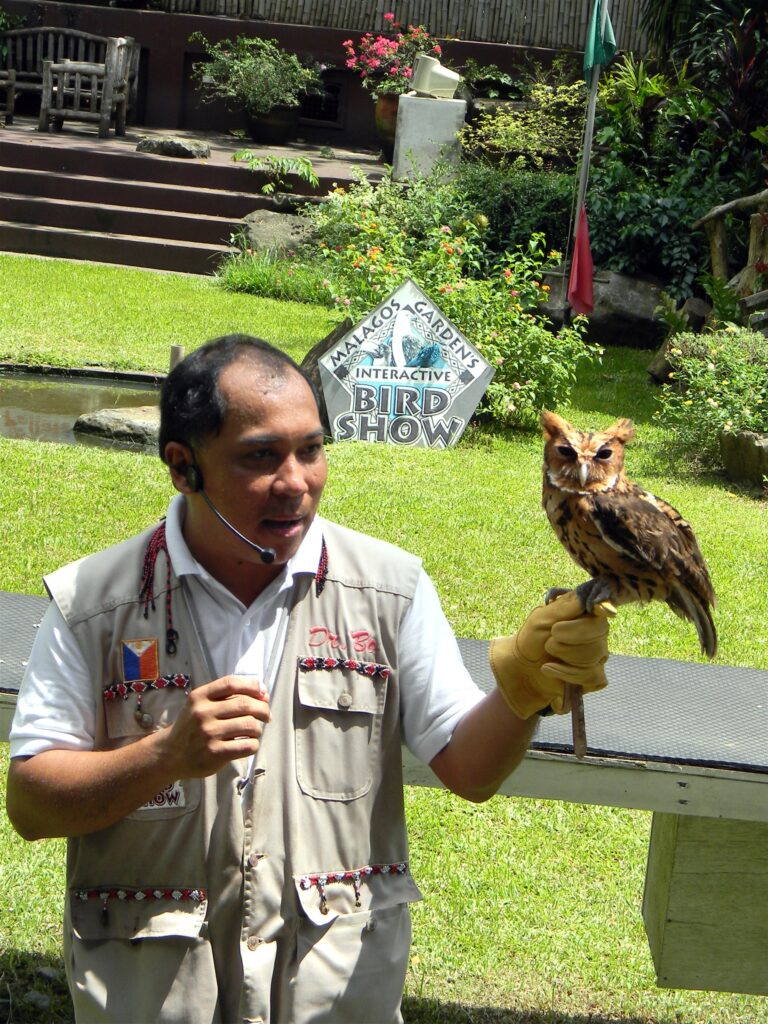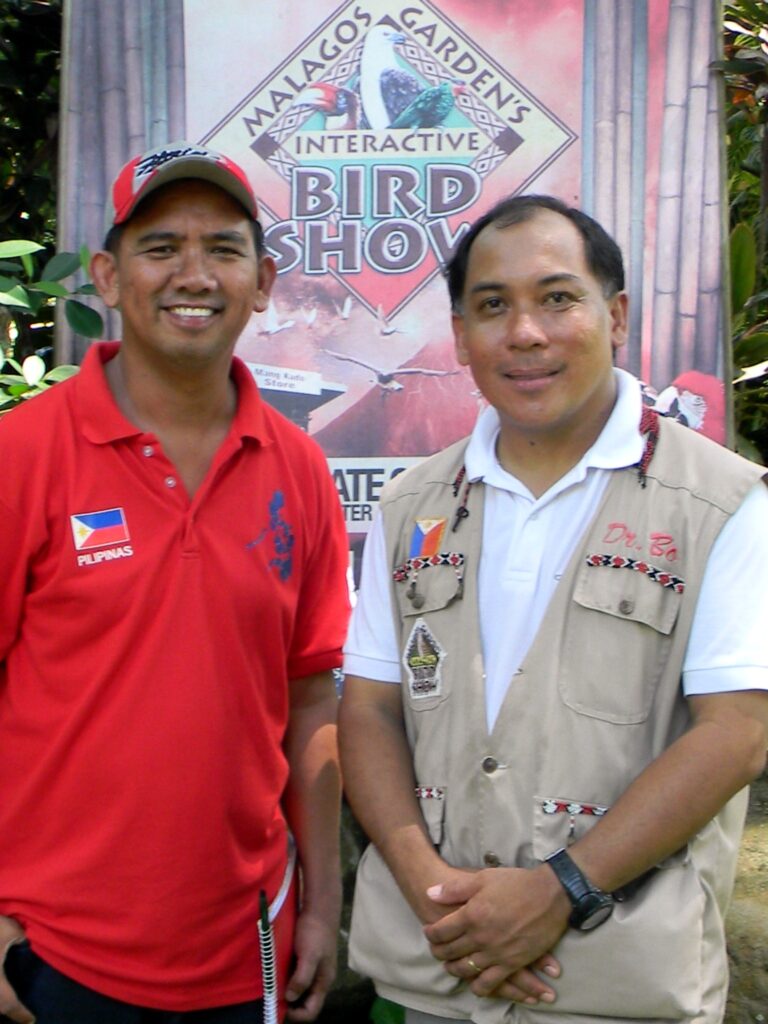Written by Henrylito D. Tacio
On November 10, 1995, Dr. Roberto Puentespina Jr – known as Dr Bo – was busy working at his veterinary clinic in Davao City, Philippines, when he received a phone call from a government official in Tandag, Surigao del Sur, that a wild caught Philippine eagle was delivered to the municipality by a farmer who claimed he saw the bird on the forest floor. It had a broken leg from snare trapping.
Upon hearing the news, Dr Bo immediately decided to go. Three people accompanied him: Edison Dayos and Lito Cereno, the animal technician and education officer, respectively of the Philippine Eagle Foundation; and Rene Lumawag, a photojournalist who documented the trip.

Tandag is about 400 kilometers east of Mindanao. Going to the place by vehicle would entail long time travel – more than a day. Fortunately, the Philippine Air Force had air assets based in Davao airport. “When the plane or helicopters are not being used, we can request them for our rescue missions. I think I went on 3 rescue flights and those birds we rescued have all survived,” Dr Bo recalls.
When the group arrived, Dr Bo immediately went to the covered gym court located at the town proper where the female juvenile eagle was confined. He saw the eagletied on one leg, with wings drooping (a sign of stress), soiled feathers, some flies around, but still alert and responsive. Generally, birds don’t show themselves as weak unless they’re about to die.
After explaining the observations of the physical exam and prognosis with some government officials and community elders, he wrapped the eagle with a clean blanket, covered the eyes with a hood, and cradled the bird in his arms. They again boarded the Philippine Air Force Islander aircraft and went back to Davao City.
Once he got back to the Philippine Eagle Conservation Center at Malagos, Calinan, Dr Bo performed the necessary tests like X-ray, blood and microbiology samples collection. He put a splint on the broken leg and gave the bird some admission drugs and food. For the next five days, he monitored the health status of the bird.

After three weeks, the eagle was on its way to full recovery. Today, the bird – named Marikit, a Tagalog term for “gorgeous” – is paired with Arakan, a male eagle that had been treated by Dr Bo also for a gunshot wound. The two are kept at the breeding cages of Philippine Eagle Conservation Center. The pair had laid their first egg last 2010 but it was infertile. Hopefully, the birds can produce again which would be hatched by the scientists working in the center. Once successfully hatched, they can be released into the wild.
Dr Bo is not working at the Philippine Eagle Conservation Center but he is doing this for his love for birds. He is one of the very few Filipinos who are experts in wildlife medicine. He became interested in birds while doing a research for Parasitology, a major subject in the Doctor of Veterinary Medicine Course at the University of the Philippines at Los Baños (UPLB).
This was in 1988, when he visited the Philippine Eagle Conservation Center, which at that time was located in Baracatan, Toril, a rebel-infested area. He wanted to go home after collecting some fecal samples to check for parasites. But he ended up staying for two days.
He met a dedicated group of workers determined to study the Philippines’s national bird, which is critically endangered. From about 500 eagles in 1980s, only 400 are left today, including the 36 eagles raised in captivity at the Eagle Center. “I was totally surprised by their dedication,” Dr Bo says. “They were far from their families. There were instances that they were caught in crossfire between military and rebels but they persevered.”
An inspiration came to him. At that time, no wildlife veterinarian was involved in Philippine Eagles. “I pledged to God that I would help His creatures. Many times I asked myself why I’m doing what I do for them – and I go back to the time when I was alone with the birds and asked God to intervene and make me His instrument.”

After graduating from college with a Doctor of Veterinary Medicine from UPLB, heco-founded a Veterinary Diagnostic Laboratory and Clinic at Cabaguio Avenue in Davao City. It offers laboratory diagnostic services to farms having poultry, piggery, and large animals.
Although practicing privately, he still visits the Philippine Eagle Conservation Center, which was busy with artificial insemination in Philippine Eagles. “Some eggs didn’t hatch, and I helped diagnosed them to be bacterially contaminated,” Dr Bo says. “These findings were largely supported by our laboratory diagnostics through microbiological swabbings.”
In 1993, his family opened the Malagos Garden Resort, which was about a kilometer away from the Philippine Eagle Conservation Center. He and his wife Olive ran the operations of the resort which back then started as a restaurant with a swimming pool.
But despite his busy schedules with his work as a veterinarian and running the operation of the resort, he still finds time to rescue the endangered Philippine Eagle. In 2000, he was so engrossed with his rescue work that he almost missed taking his wife to the hospital to give birth. At that time, he was working late with some eagle cases. “When I got home, I barely had enough time to rest when she complained of birthing symptoms and had to rush to the hospital,” he recalls. “She gave birth to our third child, Sophia, soon after.”
The Philippine Eagle is not the only birds Dr. Bo helps. In fact, when started rescuing Philippine Eagles in 1991, he had also rescued other types of eagles, parrots, hornbills, owls, cockatoos, crows, and others. Most of the birds were victims by gun shot and entrapment, illegal wildlife trade, malnutrition, parasitism, orthopaedic cases, or the lack of basic understanding on mimimum care for wildlife. A few of them had been brought to his clinic, but most were rescued. “I do rescue trips for downed eagles and other types of birds in far flung areas in Mindanao,” he says. “I use any available resources and contacts, and travel anywhere – even high-risk areas – by land or air to get them.”
Through the years, the birds he has rescued and those entrusted to him by the Department of Environment and Natural Resources ballooned. Since the 40-hectare resort is still surrounded with trees, he decided to make it as a bird sanctuary. Inside the resort are set of aviaries (some away from public view) that are designed for conservation breeding of hornbills, pheasants, parrots. The biggest is the round walk-in aviary, about 200 square-meters, located in the middle of the resort; some 25 species of birds are living and successfully breeding within. Guests are allowed to interact with the birds through supervised feeding.
“I am fortunate to have a family who supports my bird advocacy, and has allowed me to use a 3-hectare area within the resort,” he says, “but I have to be responsible to sustain the upkeep of the place as well as the human resources involved.”
Because of his passion for birds, people bring to him their injured pets or wild birds. He then decides what’s best for them once they are in better health. “We release birds that can be released after rehabilitation, especially raptors like owls, serpent eagles, kites, and crows,” he says. “Rescue and rehab activities are a team effort, and we have released at least 50 individuals of different species.”
If there are birds that cannot be released due to broken wings or leg or blindness, he pairs them for conservation breeding program. “The Palawan peacock pheasants, Nicobar Pigeons, Mount Apo Lorikeets, Mindanao tarictic hornbills, Eclectus parrots, Umbrella cockatoos, Sea Eagles, and Scops owls are some examples of successful breeding from rehabilitated birds we have kept for conservation breeding,” Dr Bo says. “I feel we are on the verge of Rufous and Mindanao writhed Hornbill breeding success.”
His last option for other birds is to use them in the bird show he conducts at the Malagos Garden Resort as part of his education efforts. “The number of birds I have adopted after rehabilitation has grown – from raptors to parrots to jungle fowls,” he says.
There are over 100 birds performing individually or as a group in the interactive bird show. “Honestly, this number is large because of the 50 white pigeons and 30 ducks parading,” he says. Only 20 birds are star performs in every show: a one eye blind Black Palm Cockatoo, two previously feather-plucked bald Cockatoo, two crows (which were rescued as chicks falling off the coconut tree), a family of Eclectus parrots (numbering five), four Brahminy Kites doing swooping flights (rehab as orphan chicks from a ranch in General Santos City), a blind frigate bird rescued from Santa Cruz, Davao del Sur (probably left from a group of migratory birds passing through) a black crowned night heron (donated from a pet lover who has kept it for a few years), an Eagle owl and two Scops owls, and two Macaws (left at their doorstep in 2003).

Dr. Bo is very much displeased with the current status of the birds in the country. The Philippines is the home of nearly 172 species that are not found anywhere else in the world. Unfortunately, half of these species are under the threat of extinction.
The reason: the destruction of their habitat – the tropical rainforest. From 17 million hectares in the early 1900s, now the country has less than one million hectares of primary natural forests left. Most of the birds, however, are also traded illegally. Much worse is that “some bird species are hunted for sports and some are hunted because they are thought to be competition for crops and fish catch,” laments Dr Bo.
According to Dr Bo, 40 percent of those birds he has rescued and rehabilitated end up in bird sanctuary, 30 percent used in breeding programs, 15 percent used in research studies, 5 percent released in the wild, and 10 percent used in his bird show. Like human beings, Dr Bo also feels a great sense of loss if a bird dies while being treated. “I am always affected,” he says.

